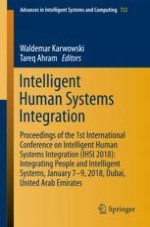This book reports on research on innovative human systems integration and human-machine interaction, with an emphasis on artificial intelligence and automation, as well as computational modeling and simulation. It covers a wide range of applications in the area of design, construction and operation of products, systems and services, including lifecycle development and human-technology interaction. The book describes advanced methodologies and tools for evaluating and improving interface usability, new models, as well as case studies and best practices in virtual, augmented and mixed reality systems, with a special focus on dynamic environments. It also discusses different factors concerning the human, hardware, and artificial intelligence software.
Based on the proceedings of the 1st International Conference on Intelligent Human Systems Integration (IHSI 2018), held on January 7-9, 2018, in Dubai, United Arab Emirates, the book also examines the forces that are currently shaping the nature of computing and cognitive systems, such as the need for decreasing hardware costs; the importance of infusing intelligence and automation, and the related trend toward hardware miniaturization and power reduction; the necessity for a better assimilation of computation in the environment; and the social concerns regarding access to computers and systems for people with special needs. It offers a timely survey and a practice-oriented reference guide to policy- and decision-makers, human factors engineers, systems developers and users alike.
